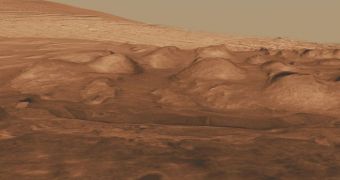One of the primary directives of the Mars Science Laboratory (MSL) rover Curiosity is to discover water on the Red Planet. The latest data suggest that the 1-ton, Mini Cooper-sized robotic explorer may be successful in its quest.
Curiosity even has a landing site now, after several years of endless debates and deliberations. Investigators in the end agreed to send the robot to Gale Crater, a massive landscape feature that has a massive mountain at its core.
Its slopes offer great promise towards revealing an in-depth, highly-detailed image of the Red Planet’s climate past. Numerous rock layers were exposed by the ancient asteroid impact that produced the crater, and the rover will have a field day analyzing them all.
Interestingly, a number of areas featuring conditions that mirror those found in Earth's desert regions are the most likely ones to hold water. Investigations have uncovered a material that looks like rust at these locations, and Curiosity will be investigating some of them.
The case for water on Mars is becoming increasingly strong, with more and more datasets adding to models of how our neighboring planet used to look like. Some of the water that once flowed on the surface, and formed an ocean in its northern hemisphere, may have not been lost for good.
Some of the clues experts interpreted as telltale signs of water include the detection of carbonates (minerals that only form in contact with water) and the presence of structures resembling channels, gullies and deltas at certain locations on the planet.
“It's possible that an important clue, the presence of carbonates, has largely escaped the notice of investigators trying to learn if liquid water once pooled on the Red Planet,” Janice Bishop says.
The expert holds an appointment as a planetary scientist at the NASA Ames Research Center, in Moffett Field, California, and also at the SETI [Search for Extraterrestrial Intelligence] Institute.
“The plausibility of life on Mars depends on whether liquid water dotted its landscape for thousands or millions of years,” adds Bishop, who is also the lead author of new study.
The paper is published in the July 1 online issue of the International Journal of Astrobiology. The expert believes that Curiosity will shed more light on the Red Planet’s water mystery when it gets there, in August 2012, Space reports.

 14 DAY TRIAL //
14 DAY TRIAL //